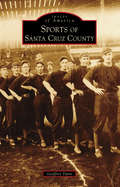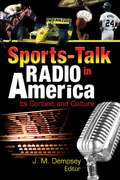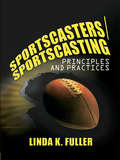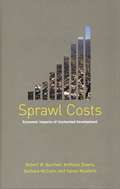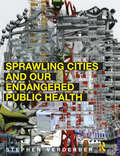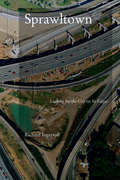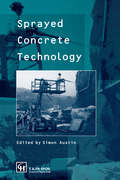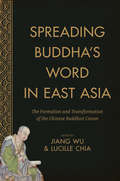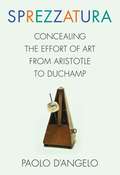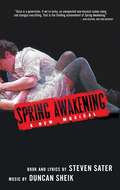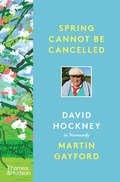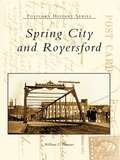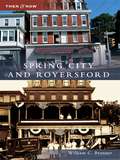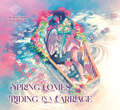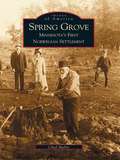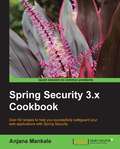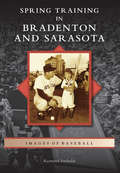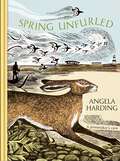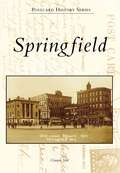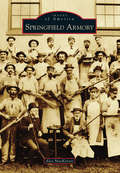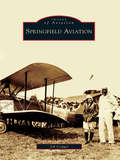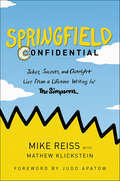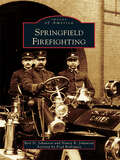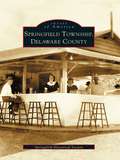- Table View
- List View
Sports of Santa Cruz County (Images of America)
by Geoffrey DunnIts inviting climate, enticing rugged mountains, and welcoming beaches have always made Santa Cruz County a haven for athletic activities. A wide variety of sporting endeavors, some beyond the norm, have called Santa Cruz home over the decades. In the 19th century, Santa Cruz served as a springboard for modern surfing. It was an early bastion for organized baseball, too, beginning in the 1860s, and it was home to a series of professional teams as early as the 1870s. Other colorful athletic activities took place here (including fire hose teams, long-distance walking, and bicycling), along with more traditional American sports like basketball, football, boxing, and tennis. The region boasts of a strong tradition of women athletes as well, in particular Marion Hollins, perhaps the greatest all-around woman athlete of the early 20th century.
Sports-Talk Radio in America: Its Context and Culture
by Frank Hoffmann Jack M. Dempsey Martin J ManningAn inside look at the hosts, hot spots, and history of sports-talk radioSports-Talk Radio in America looks at major-, medium-, and small-market stations across the United States that feature an all-sports format, with a focus on the unique personalities and programming strategies that make each station successful. Broadcasters, journalists, and academics provide insight on how and why this media phenomenon has become an important influence of American culture, examining the "guy talk" broadcasting approach, the traditional sports-emphasis approach, "HSOs" (hot sports opinions), localism in broadcasting, how sports talk radio builds "communities" of listeners, and how reckless, on-air comments can actually build ratings.For better of worse, millions of (mostly) male listeners indulge their obsession with sports to the exclusion of virtually everything else available on the radio dial-music, news, and political talk. This unique book examines how this "niche of the niche" has formed a bond between its hosts and their rabid, passionate, and loyal audiences, spinning the dial from the largest, best-known stations in big-league markets to smaller stations in Collegetown, USA, including Philadelphia&’s WIP, "The Ticket," KTCK in Dallas, WEEI in Boston, "The Team," WQTM in Orlando, KJR in Seattle, KOZN "The Zone" Omaha, Nebraska, WGR and WNSA in Buffalo, Kansas City&’s WHB, and "The Fan," WFAN in New York, the first all-sports radio station and the blueprint for the format. Sports-Talk Radio in America puts you in the studio with Mike and the Mad Dog, Angelo Cataldi, Howard Eskin, "The Musers" ("Junior" Miller and George Dunham), Norm Hitges, John Dennis and Gerry Callahan, Dan Sileo, Howard Simon, and Art Wander. Sports-Talk Radio in America examines: how stations create an environment in which listeners become part of a social group (social-identity and self-categorization theories) personality-driven programming the station&’s commitment to local teams and their fans how exploring controversial topics beyond sports broadens station&’s appeal and attracts upscale, affluent audience how an abundance of live, play-by-play broadcasting, creating plenty of available content college sports in a town without a major professional sports team how local sports is framed by hosts and callers the conflicted relationship between sports-talk radio and the print media and much more!Sports-Talk Radio in America is a must-read for academics and professionals working in radio-television and popular culture.
Sportscasters/Sportscasting: Principles and Practices
by Linda FullerA comprehensive introduction to the workings of the business, Sportscasters/Sportscasting: Principles and Practices explains all of the information essential to anyone looking to begin a career in sports media. This unique volume explores topics in print and broadcast media, sports psychology, technology issues, politics and legalities, ethics, and even the role of sports and sportscasting in society. Other topics discussed include the historical development and economics of sports and sportscasting, sports spectators, sports controversies, sociological perspectives, and sports journalism. Sportscasters/Sportscasting: Principles and Practices is filled with knowledge essential to the craft of sportscasting, including numerous appendices containing acronyms and biographic information about over 200 sportscasters, and a complete Instructor’s Manual with exercises to help guide students toward mastery of the topic.
Sprawl Costs: Economic Impacts of Unchecked Development (Report/transit Cooperative Research Program Ser.)
by Anthony Downs Sahan Mukherji Barbara Mccann Robert BurchellThe environmental impacts of sprawling development have been well documented, but few comprehensive studies have examined its economic costs. In 1996, a team of experts undertook a multi-year study designed to provide quantitative measures of the costs and benefits of different forms of growth. Sprawl Costs presents a concise and readable summary of the results of that study. The authors analyze the extent of sprawl, define an alternative, more compact form of growth, project the magnitude and location of future growth, and compare what the total costs of those two forms of growth would be if each was applied throughout the nation. They analyze the likely effects of continued sprawl, consider policy options, and discuss examples of how more compact growth would compare with sprawl in particular regions. Finally, they evaluate whether compact growth is likely to produce the benefits claimed by its advocates. The book represents a comprehensive and objective analysis of the costs and benefits of different approaches to growth, and gives decision-makers and others concerned with planning and land use realistic and useful data on the implications of various options and policies.
Sprawling Cities and Our Endangered Public Health
by Stephen VerderberSprawl is an unsustainable pattern of growth that threatens to undermine the health of communities globally. It has been a dominant mid-to-late twentieth century growth pattern in developed countries and in the twenty-first century has shown widespread signs of proliferation in India, China, and other growing countries. The World Health Organization cites sprawl for its serious adverse public health consequences for humans and ecological habitats. The many adverse impacts of sprawl on the health of individuals, communities, and biological ecosystems are well documented. Architects have been rightly criticized for failing to grasp the aesthetic and functional challenge to create buildings and places that mitigate sprawl while simultaneously promoting healthier, active lifestyles in neighbourhoods and communities. Sprawling Cities and Our Endangered Public Health examines the past and present role of architecture in relation to the public health consequences of unmitigated sprawl and the ways in which it threatens our future. Topics examined include the role of twentieth century theories of architecture and urbanism and their public health ramifications, examples of current unsustainable practices, design considerations for the creation of health-promoting architecture and landscape urbanism, a critique of recent case studies of sustainable alternatives to unchecked sprawl, and prognostications for the future. Architects, public health professionals, landscape architects, town planners, and a broad range of policy specialists will be able to apply the methods and tools presented here to counter unmitigated sprawl and to create architecture that promotes active, healthier lifestyles. Stephen Verderber is an internationally respected evidence-based researcher/practitioner/educator in the emerging, interdisciplinary field of architecture, health, and society. This, his latest book on the interactions between our buildings, our cities and our health, is an invaluable reference source for everyone concerned with sustainable architecture and landscape urbanism.
Sprawltown: Looking for the City on Its Edges
by Ingersoll RichardSprawl. The word calls to mind a host of troublesome issues such as city flight, runaway suburban development, and the conversion of farmland to soulless housing developments. In Sprawltown, architectural historian Richard Ingersoll makes the surprising claim that sprawl is an inevitable reality of modern life that should be addressed more thoughtfully and recognized as its own new form of urbanism rather than simply being criticized and condemned.In five thought-provoking chapters, covering topics such as tourism, film, and the automobile, Ingersoll takes the position that any solution to the problems of sprawl—including pressing issues like resource use and energy waste—must take into consideration its undeniable success as a social milieu. No screed against the suburb, this book offers a more sophisticated and nuanced view of the way we think about its rapid development and growth.
Sprayed Concrete Technology
by S. A. AustinThe process of spraying concrete is one of the most versatile concrete placing techniques, and is used in a wide range of applications - from construction of new tunnels, domes, tanks and pools, to repair and strengthening of existing structure. The steady growth in interest and application in the technique is reflected in this book, which brings t
Spreading Buddha's Word in East Asia: The Formation and Transformation of the Chinese Buddhist Canon (The Sheng Yen Series in Chinese Buddhist Studies)
by Lucille Chia Jiang WuA monumental work in the history of religion, the history of the book, the study of politics, and bibliographical research, this volume follows the making of the Chinese Buddhist canon from the fourth century to the digital era. Approaching the subject from a historical perspective, it ties the religious, social, and textual practices of canon formation to the development of East Asian Buddhist culture and enlivens Chinese Buddhist texts for readers interested in the evolution of Chinese writing and the Confucian and Daoist traditions.The collection undertakes extensive readings of major scriptural catalogs from the early manuscript era as well as major printed editions, including the Kaibao Canon, Qisha Canon, Goryeo Canon, and Taisho Canon. Contributors add fascinating depth to such understudied issues as the historical process of compilation, textual manipulation, physical production and management, sponsorship, the dissemination of various editions, cultic activities surrounding the canon, and the canon's reception in different East Asian societies. The Chinese Buddhist canon is one of the most enduring textual traditions in East Asian religion and culture, and through this exhaustive, multifaceted effort, an essential body of work becomes part of a new, versatile narrative of East Asian Buddhism that has far-reaching implications for world history.
Sprezzatura: Concealing the Effort of Art from Aristotle to Duchamp (Columbia Themes in Philosophy, Social Criticism, and the Arts)
by Paolo D'AngeloThe essence of art is to conceal art. A dancer or musician does not only need to perform with ability. There should also be a lack of visible effort that gives an impression of naturalness. To disguise technique and feign ease is to heighten beauty. To express this notion, Italian has a word with no exact equivalent in other languages, sprezzatura: a kind of unaffectedness or nonchalance.In this book, the first to consider sprezzatura in its own right, philosopher of art Paolo D’Angelo reconstructs the history of concealing art, from ancient rhetoric to our own times. The word sprezzatura was coined in 1528 by Baldassarre Castiglione in The Book of the Courtier to mean a kind of grace with a special essence: the ability to conceal art. But the idea reaches back to Aristotle and Cicero and forward to avant-garde works such as Duchamp’s ready-mades, all of which share the suspicion of the overt display of skill. The precept that art must be hidden turns up in a number of fields, from cosmetics to interior design, politics to poetry, the English garden to shabby chic. Through exploring different articulations of this idea, D’Angelo shows the paradox of aesthetics: art hides that it is art, but in doing so it reveals itself to be art and becomes an assertion about art. When art is concealed, it appears as spontaneous as nature—yet, paradoxically, also reveals its indebtedness to technique. An erudite and surprising tour through aesthetics, philosophy, and art history, Sprezzatura presents a strikingly original argument with deceptive ease.
Spring Awakening
by Steven Sater Duncan Sheik"This brave new musical, haunting and electrifying by turns, restores the mystery, the thrill to that shattering transformation that stirs in all our souls."--Charles Isherwood, The New York Times"The staggering purity of this show will touch all open hearts...In its refined, imaginative simplicity, it daringly reverses all the conventional rules by returning the American musical to an original state of innocence."--John Heilpern, The New York Observer"An unexpected jolt of sudden genius, edgy in its brutally honest, unromanticized depiction of human sexuality."--New York Post Spring Awakening is an extraordinary new rock musical with book and lyrics by Steven Sater and music by Grammy Award-nominated recording artist Duncan Sheik. Inspired by Frank Wedekind's controversial 1891 play about teenage sexuality and society's efforts to control it, the piece seamlessly merges past and present, underscoring the timelessness of adolescent angst and the universality of human passion. Steven Sater's plays include the long-running Carbondale Dreams, Perfect for You, Doll (Rosenthal Prize/Cincinnati Playhouse), Umbrage (Steppenwolf New Play Prize), and a reconceived version of Shakespeare's Tempest, which played in London. Duncan Sheik is a singer/songwriter who also collaborated with Sater on the musical The Nightingale. He has composed original music for The Gold Rooms of Nero and for The Public Theater's Twelfth Night in Central Park.
Spring Cannot Be Cancelled: David Hockney In Normandy
by Martin Gayford David HockneyDavid Hockney reflects upon life and art as he experiences lockdown in rural Normandy in this inspiring book which includes conversations with the artist and his latest artworks. On turning eighty, David Hockney sought out rustic tranquility for the first time: a place to watch the sunset and the change of the seasons; a place to keep the madness of the world at bay. So when Covid-19 and lockdown struck, it made little difference to life at La Grande Cour, the centuries-old Normandy farmhouse where Hockney set up a studio a year earlier, in time to paint the arrival of spring. In fact, he relished the enforced isolation as an opportunity for even greater devotion to his art. Spring Cannot Be Cancelled is an uplifting manifesto that affirms art’s capacity to divert and inspire. It is based on a wealth of new conversations and correspondence between Hockney and art critic Martin Gayford, his long-time friend and collaborator. Their exchanges are illustrated by a selection of Hockney’s new Normandy drawings and paintings alongside works by Van Gogh, Monet, Bruegel, and others. We see how Hockney is propelled ever forward by his infectious enthusiasms and sense of wonder. A lifelong contrarian, he has been in the public eye for sixty years, yet remains entirely unconcerned by the view of critics or even history. He is utterly absorbed by his four acres of northern France and by the themes that have fascinated him for decades: light, color, space, perception, water, trees. He has much to teach us, not only about how to see . . . but about how to live.
Spring City and Royersford: Through Time (Postcard History Series)
by William C. BrunnerIn 1824, the completion of the Schuylkill Canal gave birth to Spring City, and the opening of the Philadelphia and Reading Railroad in Royersford soon followed. Over the years, the "twin boroughs" grew simultaneously, sharing the community and industrial developments that their respective transportation hubs fostered. Spring City and Royersford, through more than two hundred vintage postcards, shares the history of these sister towns: the stove factories, glassworks, and knitting mills that were found on both sides of the river; the floods, fires, and train wrecks that the towns endured; and the bridges, schools, and celebrations that help unite the two communities.
Spring City and Royersford: Through Time (Then and Now)
by William C. BrunnerIn 1824, the completion of the Schuylkill Canal gave birth to Spring City, and the opening of the Philadelphia and Reading Railroad in Royersford soon followed. Over the years, the "twin boroughs" grew simultaneously, sharing the community and industrial developments that their respective transportation hubs fostered. Spring City and Royersford, through more than two hundred vintage postcards, shares the history of these sister towns: the stove factories, glassworks, and knitting mills that were found on both sides of the river; the floods, fires, and train wrecks that the towns endured; and the bridges, schools, and celebrations that help unite the two communities.
Spring Comes Riding in a Carriage: Maiden's Bookshelf (Maiden's Bookshelf #5)
by Riichi YokomitsuA more intimate and romantic entry in the Maiden's Bookshelf series, this tale of doomed romance brings together the so-called "God of Literature" with the gorgeous artwork of Atsuki Ito, author of A Love-Letter in 26 Characters.&“I can't imagine how wonderful it will be to die...&” Confined to a sickbed by the seaside, a woman waits for death as her husband nurses her. This is no tragic idyll, however; the space between them is filled with antagonism, fear, suspicion, pain...and love.Riichi Yokomitsu brings a bitingly realistic sensibility to this claustrophobic tale of love and death, asmoving as it is agonizing.
Spring Grove: Minnesota's First Norwegian Settlement
by Chad MullerSpring Grove: Minnesota's First Norwegian Settlement is a tribute to the state's earliest Norwegian emigrants, and to generations of Norwegian Americans who have made this small farming community amongst deep valleys, fjord-like bluffs, and winding streams their true vesterheim. It is a tale told through striking historic photographs, many previously unreleased, and personal narratives, often humorous and always insightful.The area was first settled in the 1850s by pioneers like James Smith, who, inspired by the landscape, named the place Spring Grove. Smith was followed by the likes of "Big" Ole Gulbransgutton, who chased crooked land surveyors out of town with his bare fist; by the innovative Mons Fladager, whose business acumen earned him the title of "Father of Spring Grove"; and by the 20th-century cartoonist Peter J. Rosendahl, whose work gave a comical voice to the challenges of cultural assimilation. Spring Grove: Minnesota's First Norwegian Settlement also conveys the universality of the Norwegian immigrant experience, and anyone with Norwegian roots who desires to learn more about their ancestors will find it an enjoyable read.
Spring Security 3.x Cookbook
by Anjana MankaleThis book follows a cookbook style exploring various security solutions provided by Spring Security for various vulnerabilities and threat scenarios that web applications may be exposed to at the authentication and session level layers.This book is for all Spring-based application developers as well as Java web developers who wish to implement robust security mechanisms into web application development using Spring Security.Readers are assumed to have a working knowledge of Java web application development, a basic understanding of the Spring framework, and some knowledge of the fundamentals of the Spring Security framework architecture. Working knowledge of other web frameworks such as Grails and so on would be an added advantage to exploit the whole breadth of recipes provided in this book, but this is not mandatory.
Spring Training in Bradenton and Sarasota (Images of Baseball)
by Raymond SinibaldiMcKechnie Field in Bradenton, Florida, is the oldest active major-league spring-training facility in the country. Opened in the spring of 1923 with Commissioner Kenesaw Mountain Landis in attendance, it has played host to six different major-league teams, with the Pittsburgh Pirates calling it home since 1969. The New York Giants traveled to Sarasota in 1924 as the first of five teams to venture to its confines. These two cities, both situated on the Gulf Coast of Florida, boast nearly a century of baseball history and have seen the game's all-time greats.
Spring Unfurled: part of a beautiful new series from beloved illustrator and print-maker Angela Harding
by Angela Harding'Spring, at all its stages, has an energy that engages us with the outside world.'Spring Unfurled is the first in a stunning seasonal quartet from beloved printmaker and illustrator Angela Harding.'Seasonal change has always been a great inspiration for my artwork. I love the changing light that brings new colours and smells. The seasons are nature's clock, bringing birds from distant shores to nest and breed in our gardens. So it is hard to say exactly when one season stops and the other begins; the changes are not necessarily gradual but come in fits and starts. Seasons have no regard for the official times written down in a calendar. Spring, more than any other of the seasons, is like this.'This pocket-sized series takes readers on a journey through the seasons, reflecting Angela's view as the nature around her transforms and evolves over the months. Taking in landscapes across the UK, from views from her home studio in Rutland to the Scottish wilderness, via the low-lying marshlands of Suffolk and the windswept hills of Yorkshire, the beautiful illustrations and evocative imagery of the prose make this the perfect book for nature lovers and art lovers everywhere.Featuring Angela's most beloved prints, alongside Angela's observations and inspirations, Spring Unfurled, Summer's Hum, Falling into Autumn and Winter's Song are a joyful celebration of nature and wildlife across the UK at all times of year.
Spring Unfurled: the beautiful new book from beloved illustrator and print-maker Angela Harding
by Angela Harding'Spring, at all its stages, has an energy that engages us with the outside world.'Spring Unfurled is the first in a stunning seasonal quartet from beloved printmaker and illustrator Angela Harding.'Seasonal change has always been a great inspiration for my artwork. I love the changing light that brings new colours and smells. The seasons are nature's clock, bringing birds from distant shores to nest and breed in our gardens. So it is hard to say exactly when one season stops and the other begins; the changes are not necessarily gradual but come in fits and starts. Seasons have no regard for the official times written down in a calendar. Spring, more than any other of the seasons, is like this.'This pocket-sized series takes readers on a journey through the seasons, reflecting Angela's view as the nature around her transforms and evolves over the months. Taking in landscapes across the UK, from views from her home studio in Rutland to the Scottish wilderness, via the low-lying marshlands of Suffolk and the windswept hills of Yorkshire, the beautiful illustrations and evocative imagery of the prose make this the perfect book for nature lovers and art lovers everywhere.Featuring Angela's most beloved prints, alongside Angela's observations and inspirations, Spring Unfurled, Summer's Hum, Falling into Autumn and Winter's Song are a joyful celebration of nature and wildlife across the UK at all times of year.
Springfield (Postcard History Series)
by Connie YenKnown as the "Queen City of the Ozarks," Springfield was founded in 1829 and became the seat of Greene County in 1835. Beginning in 1870, Springfield served as a railroad hub that connected the Ozarks culturally and financially to Kansas City, St. Louis, Chicago, and points along the East Coast. In 1938, Route 66 became part of the city's history when the legendary highway came through the public square on College Street. Built on land donated by Springfield founder John Polk Campbell, the square continues to be a vital part of the city's culture and economy. Postcard History Series: Springfield illustrates the community's growth from downtown businesses to the spread of schools, hospitals, and parks across the city.
Springfield Armory (Images of America)
by Alex MackenziePres. George Washington authorized Springfield Armory to begin manufacturing small arms for the US military in 1794. Over nearly two centuries until its closure in 1968, the government armory at Springfield, Massachusetts, became legendary, not only for the arms provided to soldiers during conflicts such as the War of 1812, the Civil War, and World War II, but also for the way in which those arms were crafted. The drive to produce firearms of high quality and quantity for the nation's military created a need to improve manufacturing methods and machinery. Armory advancements, such as the interchangeability of parts, helped lay the groundwork of the American Industrial Revolution. Because of these efforts, Springfield Armory is recognized not only as a first-rate government arms manufacturer, but also as a hub of industry, attracting thousands of skilled men and women from around the world.
Springfield Aviation (Images of Aviation)
by Job CongerCitizens of Springfield first witnessed human flight, a balloon ascent, on July 5, 1858. In 1861, the capital city's most famous resident, Abraham Lincoln, then residing in the White House, authorized the creation of the first U.S. "air force," a balloon to observe Confederate troops. Springfield's interface with aviation has been a steady stream of hot-and-cold-running enthusiasm since airplanes began flying from the state fair racetrack infield about 1910. Springfield Aviation chronicles that flow and concludes with photographs from Abraham Lincoln Capital Airport in early 2008. It presents photographs of memorable airplanes, airships, and prominent aviators from the author's extensive collection, augmented by contributions from Springfield Airport Authority, Lincoln Library's Sangamon Valley Collection, and many others.
Springfield Confidential: Jokes, Secrets, and Outright Lies from a Lifetime Writing for The Simpsons
by Mathew Klickstein Mike ReissSemi-Finalist for the 2019 James Thurber Award * One of Vulture's Top-10 Comedy Books of 2018 * A "Must" pick by Entertainment Weekly * An A.V. Club Best Books selection * A "New and Noteworthy" selection by USA TodayIn celebration of The Simpsons thirtieth anniversary, the show’s longest-serving writer and producer offers a humorous look at the writing and making of the legendary Fox series that has become one of the most revered artistic achievements in television history.Four-time Emmy winner Mike Reiss—who has worked on The Simpsons continuously since episode one in 1989—shares stories, scandals, and gossip about working with America’s most iconic cartoon family ever. Reiss explains how the episodes are created, and provides an inside look at the show’s writers, animators, actors and celebrity guests. He answers a range of questions from Simpsons fans and die-hards, and reminisces about the making of perennially favorite episodes.In his freewheeling, irreverent comic style, Reiss reflects on his lifetime inside The Simpsons—a personal highlights reel of his achievements, observations, and favorite stories. Springfield Confidential exposes why Matt Groening decided to make all of the characters yellow; dishes on what it’s like to be crammed in a room full of funny writers sixty hours a week; and tells what Reiss learned after traveling to seventy-one countries where The Simpsons is watched (ironic note: there’s no electricity in many of these places); and even reveals where Springfield is located! He features unique interviews with Judd Apatow, who also provided the foreword, and Conan O'Brien, as well as with Simpsons legends Al Jean, Nancy Cartwright, Dan Castellaneta, and more. Like Cary Elwes’ As You Wish, Jennifer Keishin Armstrong’s Seinfeldia, and Chris Smith’s The Daily Show: An Oral History, Springfield Confidential is a funny, informational, and exclusive look at one of the most beloved programs in all of television land.
Springfield Firefighting (Images of America)
by Fred Rodriguez Bert D. Johanson Nancy B. JohansonThe history of the Springfield Fire Department dates back to 1792 when the first hand pumper, Lion, was purchased. On January 24, 1794, a fire club with 50 members, all prominent citizens of the city, was organized. Fire districts were established in 1830 by an act passed by the Massachusetts legislature. By 1833, Springfield officially organized a fire department, and like the fire club, the new volunteer department consisted of prominent members of the community. The fire department changed from volunteer to paid in 1872. The volunteers then formed the Springfield Veteran Fireman's Association. After 1872, the department made great strides, especially in the area of apparatus. In 1906, Springfield entered the motorized age with the introduction of a Knox squad truck, and by 1916, Springfield became the first fullymotorized fire department in the United States.
Springfield Township, Delaware County (Images of America)
by Springfield Historical SocietyCarved out of the wilderness in the 1680s, Springfield Township was formed as Quaker families seeking religious freedom settled the area. In a region roughly bounded by Darby Creek to the east and Crum Creek to the west, the early settlers shared forests with the native Lenni Lenape tribe. Just nine miles west of the port of Philadelphia, Springfield harnessed tumbling creeks with mills during the industrial revolution and provided the growing commonwealth with edge tools from Beatty Ax Works and fabric from Victoria Plush Mill. Builders used abundant stone quarries to construct grand homes, including that of the Pennsylvania Railroad's first chief engineer, J. Edgar Thomson, who laid out the famous Horseshoe Curve and Main Line to Pittsburgh. The construction of the Media Shortline Trolley helped Springfield grow, as did the Saxon Avenue Shops and unique developments such as Windsor Circle and Rolling Road. Springfield Township documents the area's transformation into a modern town rich with amenities and community organizations.
